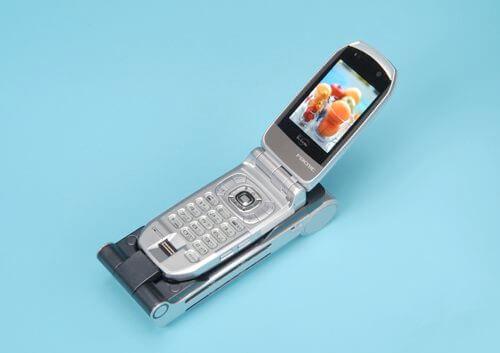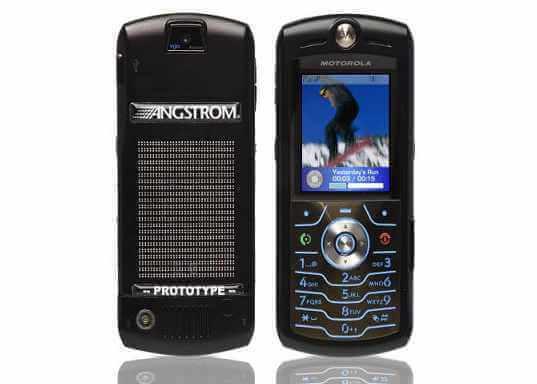Phones fuel cell
 Bashny.Net
Bashny.Net
"Durability, sustainability, efficiency" — that's what forced the developers of mobile technology to turn their attention to fuel cells. The latter, along with nanotechnology, are among the most promising directions of development of portable electronics.
Consider the main developments that have been presented by leading mobile phone producers in the area of introduction of the device of the fuel cell.
Toshiba In 2004, Toshiba has developed a small prototype fuel cell type DMFC designed for use in mobile and portable devices. The size of the device was only 22 x 56 x 4.5 mm.
The principle of operation is no different from its counterparts: oxygen and aqueous solution of methanol separated by the membrane catalyst, one side of which plays the role of cathode and the other anode. Methanol reacts with anode and is ionized, its electrons create current, positively charged ions in the interaction with the oxygen to form water. Reduce device size failed due to the lack of miniature pumps for moving the methanol and water within the cell.
Fujitsu Companies, Fujitsu and NTT DoCoMo in 2005 was upgraded with a prototype fuel cell and a rechargeable device for mobile phones.
The development was raised the concentration of methanol fuel energotekh from 30 to 99%. Such a high concentration allows the device to charge up to 3 batteries for phones FOMA, using only 18 cubic centimeters of methanol.
DoCoMo Japanese mobile operator NTT DoCoMo has developed a prototype battery charger based on miniature fuel cell for mobile phones the third generation. It is a separate device in the form of a cradle, which is inserted into the mobile phone for charging.
The main challenge facing the developers was to provide the owners the ability to recharge your phone anywhere and anytime, regardless of the availability of supply.

A prototype of the charger from NTT DoCoMo
Samsung Company Samsung Electronics has announced its Alliance with MTI Micro Fuel Cells Inc., a well known supplier of miniature fuel cell market for portable devices. The Korean company, on behalf of Samsung, was tasked with creating several prototypes of fuel cells based on methanol for mobile phones.
Also Institute of technology Samsung (SAIT) and Samsung SDI have developed a miniature battery charger for mobile phones. At an output power of 2 W, the device allows you to charge mobile phones, PDAs, digital cameras and other portable equipment 5 times faster than analogues. The source of power for the charger is the methanol cartridge.
According to representatives of Samsung, the product is ready for industrial production. The advantage of the new invention is the removal of potentially dangerous cartridge with poisonous methanol in a separate feeding device.
NEC In January 2008, NEC introduced the world's first mobile phone model in the fuel element Flask (Flask).

The phone fuel cell from Toshiba
The unusual design of the phone due to its focus on a female audience. At the same time, the transparency of the body has functional value: at any time, you can see the battery level.
Sony in Spring 2008 and the international conference Small Fuel Cells 2008, Sony Corporation was presented a hybrid fuel cell. It feature are small size: the dimensions of the new power source made up 50x 30 mm.
The role fuel plays an aqueous solution of methanol, which is fed into the device a miniature pump. The assurances by Sony, the power output is about three watts, which is enough to power portable devices in peak mode. At the same tank with ten milliliters of methanol, alleged to be sufficient for viewing on the mobile phone screen television for fourteen hours.
In the future, Sony plans to start mass production of hybrid fuel cells. However, when this will happen is not specified.
Motorola and Angstrom Power Company Angstrom Power and Motorola showcased their own version of a mobile phone running on battery and based on the new hydrogen fuel cells.

The phone fuel cell from Motorola and Angstrom Power
Innovation the company was the fact that the energy is generated not from methanol (as in the previous developments), and from hydrogen produced from distilled water.
Yet Angstrom Power and Motorola have not announced the beginning of serial production of the phone. The company intends to demonstrate his invention at exhibitions and conferences.
It should be noted that the use of fuel cells has its drawbacks: for energy production requires the purest water, the volume of which is limited. In addition, if the hydrogen generator is completely discharged, still need an initial power source to start generation.
As for methanol, it is to date not resolved the issue of the use of such products on Board the plane, where the entrance with flammable substances is prohibited (methanol). Also, there is debate about the sustainability and safety of this type of energy.
So, while these shortcomings are not resolved, talking about the replacement of fuel-cell Li-ion batteries yet. Full-fledged entry into the market of such equipment are only expected to be 2015-2020.published
P. S. And remember, only by changing their consumption — together we change the world! ©
Join us in Facebook , Vkontakte, Odnoklassniki
Source: www.cleandex.ru/articles/2016/04/24/mobile-fuel-cell
Consider the main developments that have been presented by leading mobile phone producers in the area of introduction of the device of the fuel cell.
Toshiba In 2004, Toshiba has developed a small prototype fuel cell type DMFC designed for use in mobile and portable devices. The size of the device was only 22 x 56 x 4.5 mm.
The principle of operation is no different from its counterparts: oxygen and aqueous solution of methanol separated by the membrane catalyst, one side of which plays the role of cathode and the other anode. Methanol reacts with anode and is ionized, its electrons create current, positively charged ions in the interaction with the oxygen to form water. Reduce device size failed due to the lack of miniature pumps for moving the methanol and water within the cell.
Fujitsu Companies, Fujitsu and NTT DoCoMo in 2005 was upgraded with a prototype fuel cell and a rechargeable device for mobile phones.
The development was raised the concentration of methanol fuel energotekh from 30 to 99%. Such a high concentration allows the device to charge up to 3 batteries for phones FOMA, using only 18 cubic centimeters of methanol.
DoCoMo Japanese mobile operator NTT DoCoMo has developed a prototype battery charger based on miniature fuel cell for mobile phones the third generation. It is a separate device in the form of a cradle, which is inserted into the mobile phone for charging.
The main challenge facing the developers was to provide the owners the ability to recharge your phone anywhere and anytime, regardless of the availability of supply.

A prototype of the charger from NTT DoCoMo
Samsung Company Samsung Electronics has announced its Alliance with MTI Micro Fuel Cells Inc., a well known supplier of miniature fuel cell market for portable devices. The Korean company, on behalf of Samsung, was tasked with creating several prototypes of fuel cells based on methanol for mobile phones.
Also Institute of technology Samsung (SAIT) and Samsung SDI have developed a miniature battery charger for mobile phones. At an output power of 2 W, the device allows you to charge mobile phones, PDAs, digital cameras and other portable equipment 5 times faster than analogues. The source of power for the charger is the methanol cartridge.
According to representatives of Samsung, the product is ready for industrial production. The advantage of the new invention is the removal of potentially dangerous cartridge with poisonous methanol in a separate feeding device.
NEC In January 2008, NEC introduced the world's first mobile phone model in the fuel element Flask (Flask).

The phone fuel cell from Toshiba
The unusual design of the phone due to its focus on a female audience. At the same time, the transparency of the body has functional value: at any time, you can see the battery level.
Sony in Spring 2008 and the international conference Small Fuel Cells 2008, Sony Corporation was presented a hybrid fuel cell. It feature are small size: the dimensions of the new power source made up 50x 30 mm.
The role fuel plays an aqueous solution of methanol, which is fed into the device a miniature pump. The assurances by Sony, the power output is about three watts, which is enough to power portable devices in peak mode. At the same tank with ten milliliters of methanol, alleged to be sufficient for viewing on the mobile phone screen television for fourteen hours.
In the future, Sony plans to start mass production of hybrid fuel cells. However, when this will happen is not specified.
Motorola and Angstrom Power Company Angstrom Power and Motorola showcased their own version of a mobile phone running on battery and based on the new hydrogen fuel cells.

The phone fuel cell from Motorola and Angstrom Power
Innovation the company was the fact that the energy is generated not from methanol (as in the previous developments), and from hydrogen produced from distilled water.
Yet Angstrom Power and Motorola have not announced the beginning of serial production of the phone. The company intends to demonstrate his invention at exhibitions and conferences.
It should be noted that the use of fuel cells has its drawbacks: for energy production requires the purest water, the volume of which is limited. In addition, if the hydrogen generator is completely discharged, still need an initial power source to start generation.
As for methanol, it is to date not resolved the issue of the use of such products on Board the plane, where the entrance with flammable substances is prohibited (methanol). Also, there is debate about the sustainability and safety of this type of energy.
So, while these shortcomings are not resolved, talking about the replacement of fuel-cell Li-ion batteries yet. Full-fledged entry into the market of such equipment are only expected to be 2015-2020.published
P. S. And remember, only by changing their consumption — together we change the world! ©
Join us in Facebook , Vkontakte, Odnoklassniki
Source: www.cleandex.ru/articles/2016/04/24/mobile-fuel-cell
Tags
See also
Dresses for the red carpet
13 things that men and women do differently
You will tremble with excitement when you see what she did of old sweaters. Necessary thing!
10 mysterious technology of ancient Egypt, which still does not explain
To leave, to return
iPotty - children pot holder for tablets















